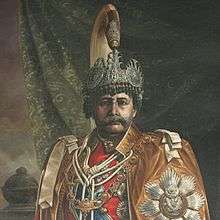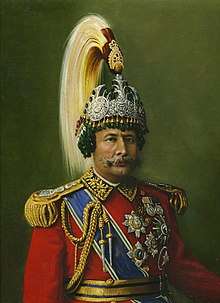Mohan Shumsher Jang Bahadur Rana
Field-Marshal Shree Shree Shree Maharaja Sir Mohan Shumsher Jung Bahadur Rana (Nepali: मोहन शम्शेर जङ्गबहादुर राणा), GCB, GCIE, GBE (23 December 1885 – 6 January 1967) was the prime minister and foreign minister of Nepal from 30 April 1948 until 12 November 1951.[2]
Mohan Shamsher Jang Bahadur Rana, GCB, GCIE, GBE | |
|---|---|
श्री ३ मोहन शमशेर जङ्गबहादुर राणा | |
 Portrait of Mohan Shamsher | |
| 17th Prime Minister of Nepal | |
| In office 30 April 1948 – 12 November 1951 | |
| Monarch | King Tribhuvan King Gyanendra |
| Preceded by | Padma Shumsher JBR |
| Succeeded by | Matrika Prasad Koirala |
| Personal details | |
| Born | 23 December 1885 |
| Died | 6 January 1967 (aged 81) Bangalore |
| Parents | Chandra Shumsher Jang Bahadur Rana (father) Chandra Loka Bhakta Lakshmi Devi (mother) |
| Occupation | Prime Minister of Nepal |
| Shree Teen Maharaja Mohan Shamsher Jang Bahadur Rana श्री ३ महाराज मोहन शम्शेर जङ्गबहादुर राणा | |||||
|---|---|---|---|---|---|
| King of Lamjung and Kaski Kingdom His Highness Field-Marshal Svasti Sri Madati Prachandra Bhujadandyetyadi Sri Sri Sri Maharaja T'ung-ling-ping-ma-Kuo-Kang-Wang Knight Grand Cross of the Order of the Bath Knight Grand Commander of the Order of the Indian Empire Knight Grand Cross of the British Empire | |||||
 | |||||
| Reign | 1948 – 1951 | ||||
| Coronation | 1948[1] | ||||
| Predecessor | Padma Shumsher Jung Bahadur Rana | ||||
| Successor | abolished | ||||
| Issue | Sharada Shumsher Jung Bahadur Rana Bijaya Shamsher Jang Bahadur Rana | ||||
| |||||
| Dynasty | Rana dynasty | ||||
| Religion | Hinduism | ||||
He was the last prime minister from the Rana family, which had controlled Nepal for more than a century and reduced the monarchy to a figurehead. He was the son of the 5th Rana Prime Minister of Nepal Chandra Shumsher and Bada Maharani Chandra Loka Bhakta Lakshmi Devi. He became prime minister at a time when the king, Tribhuvan was attempting to assert himself. Tribhuvan wanted to establish a stronger monarchy and some democracy, which Mohan Shamsher opposed.
In 1950, Mohan Shumsher's policies against the monarchy forced Tribhuvan and his son Mahendra to flee to India with the help of the Indian Residency and the Indian government, which led Mohan Shamhser to proclaim Mahendra's three-year-old son Gyanendra the king of Nepal.
Later in the revolution of 1951, Tribhuvan returned to Nepal after signing The Delhi Treaty between Mohan Shamhser, Tribhuvan and Nepali Congress thus restoring his throne and bringing the stately power back to the monarch. By the end of 1951, the king and his allies, the Nepali Congress had triumphed, and Mohan Shumsher and the rest of the Rana family lost power. The Ranas were deprived of all the hereditary offices and privileges conferred by king Surendra Bikram Shah on Jang Bahadur even though Mohan Shumsher still held the office of the prime minister for until several demonstrations by Ranas in an attempt to reestablish their rule and the opposition of the monarchy and Nepali Congress forced him to resign from his position.
Death
On 14 December 1951, Mohan Shumsher went into self-imposed exile in India, and died in Bangalore in 1967, aged 81.
Family
In 1900, he married Bada Maharani Dikshya Kumari, second daughter of Kunwar Indar Bir Singh Rathor, of Marma Doti. He had two sons and six daughters,[3]
- General Sharda Shamsher Jung Bahadur Rana, elder son. He was the father of five children, two sons and three daughters, and all his daughters were given in marriage to high-ranking Rajput Maharajas. His daughters were:
- Deepak Shamsher Jung Bahadur Rana, elder son
- Mukund Shamsher Jung Bahadur Rana, younger son
- HH Maharani Mukut Rajya Lakshmi Devi, wife of HH Maharaja Raghunath Singh Bhati of Jaisalmer
- HH Maharani Yasho Rajya Lakshmi Devi, wife of HH Maharaja Karan Singh Dogra of Jammu and Kashmir
- Bharati/Chaitanya Rajya Lakshmi, wife of HH Maharaja Shatrushalya Singh Jadeja of Nawanagar (Jamnagar). She divorced her husband and married a Punjabi businessman.
- General Bijay Shamsher Jung Bahadur Rana, younger son. Married and had issue one son and at least one daughter (maybe three daughters including:
- Pashupati Shamsher Jang Bahadur Rana. A politician who held several ministerial positions in the government of Nepal at various times. He married Usharaje Scindia, second daughter of Maharaja Jiwajirao Scindia of Gwalior by his wife Maharani Vijayaraje Scindia. They became the parents of two daughters:
- Urvashi Rana, married an Indian businessman from the Marwadi community.
- Devyani Rana
- Dharma Rajya Lakshmi Devi. Married to Maharaj Devi Singh, fourth son of HH Maharaja Umaid Singh of Jodhpur.
- Pashupati Shamsher Jang Bahadur Rana. A politician who held several ministerial positions in the government of Nepal at various times. He married Usharaje Scindia, second daughter of Maharaja Jiwajirao Scindia of Gwalior by his wife Maharani Vijayaraje Scindia. They became the parents of two daughters:
- Rani Sahiba Moha Bakhta Rajya Lakshmi Devi, married to Raja Pashupati Pratap Narayan Singh Bahadur of Bansi in Uttar Pradesh.
- Rani Sahiba Thagendra Rajya Lakshmi Devi, married to Rao Udai Singh of Patan, Rajasthan.
- Rani Sahiba Roop Rajya Lakshmi Devi, married to Rawal Sangram Singh of Samode in Rajasthan.
- Rani Sahiba Mahendra Rajya Lakshmi Devi, married to Rana Shivambar Singh of Khajurgaon.
- Rani Sahiba Sharada Rajya Lakshmi Devi, married to Raja Girish Chandra Jadumoni Deo Jenamani of Rairakhol State in Orissa.
- HH Rani Sahiba Leela Rajya Lakshmi, married to HH Maharaja Sir Arimardam Singh Ju Deo Bahadur of Charkhari State in Bundelkhand.
Honours









Ancestors
| Ancestors of Mohan Shumsher Jang Bahadur Rana | ||||||||||||||||||||||||||||||||||||||||||||||||||||||||||||||||||||||||||||||||||||||||||||||||||||||||||||||||||||||||||||||||||||||||||||||||||||||||||||||||||||||||||||||||||||||||||||||||||||||||||||||||||||||||||||||||||||||||||||||||||||||||||||||||||||||||||||||||||||||||||||||||||||||||||||||||||||||||||||||||||||||||||||||||||||||||||||||||||||||||||||||||||||||||||||||||||||||||||||||||||||||||||||||||||||||||||||||||||||||||||||||||||||||||||||||||||||||||||||||||||||||||||||||||||||||||||||||||||||||||||||||||||||||||||||||||||||||||||||||||||||||||||||||||||||||||||||||||||||||||||||||||||||||||||||||||||||||||||||||||||||||||||||||||||||||||||||||||||||||||||||||||||||||||||||||||||||||||||||||||||||||||||||||||||||||||||||||||||||||||||||||||||||||||||||||||||||||||||||||||||||||||||||||||||||||||||||||||||||||||||||||||||||||||||||||||||||||||||||||||||||||||||||||||||||||||||||||||||||||||||||||||||||||||||
|---|---|---|---|---|---|---|---|---|---|---|---|---|---|---|---|---|---|---|---|---|---|---|---|---|---|---|---|---|---|---|---|---|---|---|---|---|---|---|---|---|---|---|---|---|---|---|---|---|---|---|---|---|---|---|---|---|---|---|---|---|---|---|---|---|---|---|---|---|---|---|---|---|---|---|---|---|---|---|---|---|---|---|---|---|---|---|---|---|---|---|---|---|---|---|---|---|---|---|---|---|---|---|---|---|---|---|---|---|---|---|---|---|---|---|---|---|---|---|---|---|---|---|---|---|---|---|---|---|---|---|---|---|---|---|---|---|---|---|---|---|---|---|---|---|---|---|---|---|---|---|---|---|---|---|---|---|---|---|---|---|---|---|---|---|---|---|---|---|---|---|---|---|---|---|---|---|---|---|---|---|---|---|---|---|---|---|---|---|---|---|---|---|---|---|---|---|---|---|---|---|---|---|---|---|---|---|---|---|---|---|---|---|---|---|---|---|---|---|---|---|---|---|---|---|---|---|---|---|---|---|---|---|---|---|---|---|---|---|---|---|---|---|---|---|---|---|---|---|---|---|---|---|---|---|---|---|---|---|---|---|---|---|---|---|---|---|---|---|---|---|---|---|---|---|---|---|---|---|---|---|---|---|---|---|---|---|---|---|---|---|---|---|---|---|---|---|---|---|---|---|---|---|---|---|---|---|---|---|---|---|---|---|---|---|---|---|---|---|---|---|---|---|---|---|---|---|---|---|---|---|---|---|---|---|---|---|---|---|---|---|---|---|---|---|---|---|---|---|---|---|---|---|---|---|---|---|---|---|---|---|---|---|---|---|---|---|---|---|---|---|---|---|---|---|---|---|---|---|---|---|---|---|---|---|---|---|---|---|---|---|---|---|---|---|---|---|---|---|---|---|---|---|---|---|---|---|---|---|---|---|---|---|---|---|---|---|---|---|---|---|---|---|---|---|---|---|---|---|---|---|---|---|---|---|---|---|---|---|---|---|---|---|---|---|---|---|---|---|---|---|---|---|---|---|---|---|---|---|---|---|---|---|---|---|---|---|---|---|---|---|---|---|---|---|---|---|---|---|---|---|---|---|---|---|---|---|---|---|---|---|---|---|---|---|---|---|---|---|---|---|---|---|---|---|---|---|---|---|---|---|---|---|---|---|---|---|---|---|---|---|---|---|---|---|---|---|---|---|---|---|---|---|---|---|---|---|---|---|---|---|---|---|---|---|---|---|---|---|---|---|---|---|---|---|---|---|---|---|---|---|---|---|---|---|---|---|---|---|---|---|---|---|---|---|---|---|---|---|---|---|---|---|---|---|---|---|---|---|---|---|---|---|---|---|---|---|---|---|---|---|---|---|---|---|---|---|---|---|---|---|---|---|---|---|---|---|---|---|---|---|---|---|---|---|---|---|---|---|---|---|---|---|---|---|---|---|---|---|---|---|---|---|---|---|---|---|---|---|---|---|---|---|---|---|---|---|---|---|---|---|---|---|---|---|---|---|---|---|---|---|---|---|---|---|---|---|---|---|---|---|---|---|---|---|---|---|---|---|---|---|---|---|---|---|---|---|---|---|---|---|---|---|---|---|---|---|---|---|---|---|---|---|---|---|---|---|---|---|---|---|---|---|---|---|---|---|---|---|---|---|---|---|---|---|---|---|---|---|---|---|---|---|---|---|---|---|---|---|---|---|---|---|---|---|---|---|---|---|---|---|---|---|---|---|---|---|---|---|---|---|---|---|---|---|---|---|---|---|---|---|---|---|---|---|---|---|---|---|---|---|---|---|---|---|---|---|---|---|---|---|---|---|---|---|---|---|---|---|---|---|---|---|---|---|---|---|---|---|---|---|---|---|---|---|---|---|---|---|---|---|---|---|---|---|---|---|---|---|---|---|---|---|---|---|---|---|---|---|---|---|---|---|---|---|---|---|---|---|---|---|---|---|---|---|---|---|---|---|---|---|---|---|---|---|---|---|---|---|---|---|---|---|---|---|---|---|---|---|---|---|---|---|---|---|---|---|---|---|---|---|---|---|---|---|---|---|---|---|---|---|---|---|---|---|---|---|---|---|---|---|---|---|---|---|---|---|---|---|---|---|---|---|---|---|---|---|---|---|
| ||||||||||||||||||||||||||||||||||||||||||||||||||||||||||||||||||||||||||||||||||||||||||||||||||||||||||||||||||||||||||||||||||||||||||||||||||||||||||||||||||||||||||||||||||||||||||||||||||||||||||||||||||||||||||||||||||||||||||||||||||||||||||||||||||||||||||||||||||||||||||||||||||||||||||||||||||||||||||||||||||||||||||||||||||||||||||||||||||||||||||||||||||||||||||||||||||||||||||||||||||||||||||||||||||||||||||||||||||||||||||||||||||||||||||||||||||||||||||||||||||||||||||||||||||||||||||||||||||||||||||||||||||||||||||||||||||||||||||||||||||||||||||||||||||||||||||||||||||||||||||||||||||||||||||||||||||||||||||||||||||||||||||||||||||||||||||||||||||||||||||||||||||||||||||||||||||||||||||||||||||||||||||||||||||||||||||||||||||||||||||||||||||||||||||||||||||||||||||||||||||||||||||||||||||||||||||||||||||||||||||||||||||||||||||||||||||||||||||||||||||||||||||||||||||||||||||||||||||||||||||||||||||||||||||
References
| Political offices | ||
|---|---|---|
| Preceded by Padma Shamsher Jang Bahadur Rana |
Prime Minister of Nepal 1948–1951 |
Succeeded by Matrika Prasad Koirala |